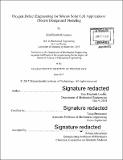| dc.contributor.advisor | Tonio Buonassisi. | en_US |
| dc.contributor.author | Looney, Erin Elizabeth | en_US |
| dc.contributor.other | Massachusetts Institute of Technology. Department of Mechanical Engineering. | en_US |
| dc.date.accessioned | 2017-10-04T15:05:10Z | |
| dc.date.available | 2017-10-04T15:05:10Z | |
| dc.date.copyright | 2017 | en_US |
| dc.date.issued | 2017 | en_US |
| dc.identifier.uri | http://hdl.handle.net/1721.1/111715 | |
| dc.description | Thesis: S.M., Massachusetts Institute of Technology, Department of Mechanical Engineering, 2017. | en_US |
| dc.description | Cataloged from PDF version of thesis. | en_US |
| dc.description | Includes bibliographical references (pages 78-82). | en_US |
| dc.description.abstract | One of the main remaining impurities that lowers efficiencies of silicon solar cells are oxygen ring defects that are incorporated into the material during growth. These defects decrease overall cell efficiencies by around 20% (rel.) resulting in a yield loss of about 1/4 h of each monocrystalline silicon ingot. To control the oxygen defects and put them in the least harmful form possible, a new cell processing step call tabula rasa (TR) is explored. TR is a high temperature process for a short duration. In this work, TR is found to be a kinetically-limited process through several oxygen precipitate dissolution experiments from which the activation energy of dissolution is found to be equivalent to the migration enthalpy for oxygen in silicon. With this knowledge, a predictive kinetic model is built which can be used for process optimization. A multiscale end-to-end model is also developed to determine the effect of rings on cell performance. Using oxygen defect parameter inputs, device modelling, and a spatially resolved two diode mesh, PL images are transformed into current maps and used to determine cell efficiencies for inhomogeneously distributed defects. A reduction in efficiency for cells with ring defects is simulated for several ring defect concentrations and compared to a non-defective cell. Another strategy for lowering cost and mitigating oxygen ring defects is using thinner silicon absorbers with inherent defect tolerance. Using the multiscale modeling platform described above, thin silicon wafers are compared to typical cells. It is shown that thin cells with ring defects perform with higher efficiencies, with less than half the material used. The thin silicon strategy is compared with the TR process addition, and future work is outlined to further explore these oxygen mitigation options. | en_US |
| dc.description.statementofresponsibility | by Erin Elizabeth Looney. | en_US |
| dc.format.extent | 82 pages | en_US |
| dc.language.iso | eng | en_US |
| dc.publisher | Massachusetts Institute of Technology | en_US |
| dc.rights | MIT theses are protected by copyright. They may be viewed, downloaded, or printed from this source but further reproduction or distribution in any format is prohibited without written permission. | en_US |
| dc.rights.uri | http://dspace.mit.edu/handle/1721.1/7582 | en_US |
| dc.subject | Mechanical Engineering. | en_US |
| dc.title | Oxygen defect engineering for silicon solar cell applications : process design and modeling | en_US |
| dc.type | Thesis | en_US |
| dc.description.degree | S.M. | en_US |
| dc.contributor.department | Massachusetts Institute of Technology. Department of Mechanical Engineering | |
| dc.identifier.oclc | 1004225803 | en_US |
